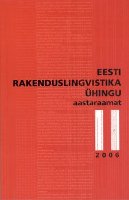Eesti vahekeelekorpusest korrelatsioonigrammatikani
Estonian interlanguage corpus: Wishes and reality
Author(s): Pille EslonSubject(s): Language and Literature Studies
Published by: Eesti Rakenduslingvistika Ühing (ERÜ)
Keywords: corpus linguistics; language classifications; analogy; correlation grammar; error classification
Summary/Abstract: Estonian interlanguage corpus (EIC) is being created at the Chair of General and Applied Linguistics at Tallinn University. The corpus contains the students’ term papers; it is compiled and electronically processed on the purpose of specific research. In order to create the concordance program of EIC the notion of error and the basis of error classification had to be determined. After that it was possible to create a multidimensional classification of errors, which is constructed as a dependency tree and is dividable into algorithms. In EIC an error is defined as language use that is not in accordance with grammar rules. The errors have been identified and analysed from the contrastive linguistics point of view. The main argument in explaining the errors is interference between L1 and L2. Further developments (contrastive and error analysis, interlanguage research) depend on the theory of contrastive analysis and studies carried out on creating a functional model of language. In essence, it is a description of connections that occur in the behaviour of elements in two different language systems. The author of the article refers to such a model as correlation grammar. Unlike contrastive grammar, its aim is to point out the differences and functional similarities between the languages. Such dependencies are observable by investigating similar features in the function of words and phrases.
Journal: Eesti Rakenduslingvistika Ühingu aastaraamat
- Issue Year: 2006
- Issue No: 2
- Page Range: 011-024
- Page Count: 13
- Language: Estonian

